When I went off to my first FS job in 1985, I was told that my job was to represent the American nation, not only the current occupant of the WH. Of course we advocated administration policies, but we also brought in speakers and programs of legitimate American opinion that disagreed. America does not speak with one voice and neither did we. When I managed the speaker program in 2007, I specifically directed that our speakers represent the diversity of American opinion, again not only the point of view of the current occupant of the WH. It is a tribute to wise political leadership that I not only got away with that but also prospered.
It is a difficult balance. Of course, we work for the President, but we expect that a wise president will recognize his limitations and know that the American government is greater than the American president and that the American nation is greater than both.
In an always uncertain world, we can never know which of our efforts will be most successful and useful. That is why we need to have lots of things working, some of them contradictory. It is the strength of diversity not that any particular option is best but that among the many some will be the right ones.
I have worked with political appointees who were excellent. They bring an important perspective that we professionals usually lack. But the effectiveness comes more from the tension between professionals and political than from the harmony among them. If the balance tips too far in the political direction, we will be missing out on having different paths forward when conditions warrant or political leadership changes, as it always does.
Whether we welcome or dread it, all professionals must look forward to working for a different political leadership and serving a new president with equal vigor as we serve the current one, just as we served the predecessor as eagerly as we do the current leader.
In my experience, political appointees often do not understand this. They think that their man in the WH is the culmination of some sort of historical process, that we are happy to be rid of the old guy and embracing the new. This is true for some of us sometimes, but we must curb our enthusiasm or distaste because that is what professionals do.
Golden fall

October is one of the best times for Washington. We get crisp clear days, cool and not very humid but sunny. I am taking advantage of this window of beauty, riding my bike to work and walking as much as I can.
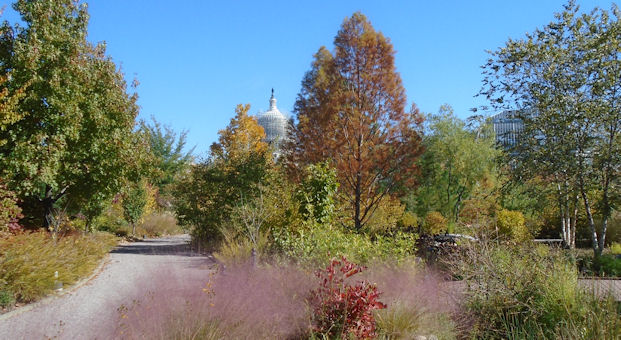
Today I wandered over to the Botanical Gardens at lunchtime. It is a small area but packed with pleasantness. They used plants from around the middle Atlantic region, so we have the familiar longleaf & loblolly pines and lots of oaks and cedars. I just like to be there. You really don’t have to own your own stuff if you can use these nice places. But I also find it humbling. They mark the trees and plants. I pride myself on being able to identify trees, but my pride is misplaced. I can tell the general groups. For example, I can tell a loblolly pine from a longleaf or a white pine. But they have pond pines and pitch pines that I could not separate from the loblolly. I also have trouble telling black oaks from red oaks. When I know that is it a black oak, I can see why it is, difference in leaves etc. but I would be unable to do it in general.

I have also been trying to get to the Smithsonian Museums. The great thing about Smithsonian is that all the museums are free, so you can go in for a short time w/o having to spend the big bucks or feeling that you have to see everything to “make it worth it.” I went to the National Gallery of Art. You could spend a lot of time there. They provide comfortable places to sit surrounded by light and beauty. This is the proper way to appreciate art, taking the time to hang around. I looked at lots of the paintings but I lingered in the Impressionist section. Chrissy likes Monet and Renoir. I am no expert. I could not tell one impressionist from another and don’t expect ever to learn, but I enjoyed the brightness, the light.

We went to see the movie “Fury” over the weekend. It stars Brad Pitt, who looks so much like me. Anyway, it is a very violent movie with scores of people being killed every minute. It takes place in Germany in April, 1945. The war is almost over but there remains desperate resistance, with children and old people pressed into service. I was thinking about that as I walked around my beautiful Washington on a perfect day. Germany was so utterly destroyed by the war. All over Europe centuries of culture and art were lost, stolen or destroyed; life was reduced to its basic elements. The most civilized, progressive and prosperous parts of the world debauched into barbarism that killed millions and brutalized millions more. The Impressionist light was out of place. Washington could be reduced to this someday. It seems impossible now, but I don’t expect the Germans, Poles, French and others really thought it would ever happen to them, or at least not in their lifetimes of that of their children. I think of the Romans watching the Visigoths come over the hills and uttering the Latin equivalent of “Oh shit; what the hell happened?” Nobody for hundreds of years had believed such a thing even remotely possible. We like to think such savagery is in the past, but there are place right now that it is going on like then.
But we cannot let it end like that.
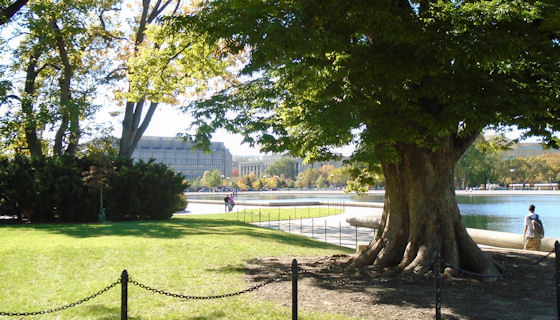
My pictures are from near the Capitol. You can see that they are reconstructing the Capitol Dome. It is made of iron, which has rusted and needs to be fixed. The other pictures are from the Botanical Garden, except the one on the bottom, which is a big zelkova tree near the pool in front of General Grant’s monument. Zelkovas are in the elm family and resemble shorter versions of the American elm in that they have a vase shape. But they tend to be squatter and thicker, as you can see above. They don’t usually get Dutch elm disease, which is why they were planted to replace dying American elms in the 1970s. Washington is a pleasant place most of the time.
W&OD bike trail
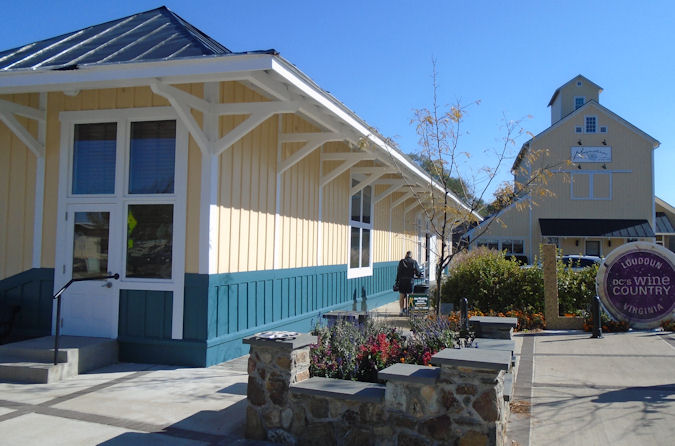
I have been meaning to ride the W&OD trail from the start and finally got around to it. Alex dropped me off at the start of the trail in Purcellville. It was about forty miles to my house. It was a perfect day for it, with temperatures at around 65 degrees and a wind of about eight MPH from west/northwest, i.e. mostly a tailwind.

The trail is pretty flat but tending down from west to east. You can see above the deep cut and they cut into the hills and filled in the low points. W&OD was the Washington and Old Dominion railroad line. Trains were unable to go up grades that were too steep. Standard maximum grade for the 19th century railroads was 2.2% or 110 feet per mile. What was good for trains is good for bikes.
One drawback to the trail is that there are no shops and restaurants right on the trail. I suppose this is not generally a problem. You can find accommodations not very far away, but besides one establishment called Carolina Brothers Barbeque at mile 27 in Ashburn, you don’t have a direct trail access. I stopped at a place called Old Ox Brewery just before mile 25. You had to go a dirt path from the trail, but it seemed a nice place. I had a small beer before going on. You can see from the bike rack that others had similar ideas.

I am glad I finally made the journey. I have been thinking about it since I first discovered the trail back in 1997. I run on part of the trail and I use it to ride my bike to work, but going the other way is harder. It is more uphill and there really is no place to go. I enjoy riding my bike, especially on these nice October days. But I think that when you get much beyond an hour of riding, it becomes more a challenge than just a pleasure. It is one of those things that is good to have done. I doubt I will do it again.
Everything is free; you just have to go and get it
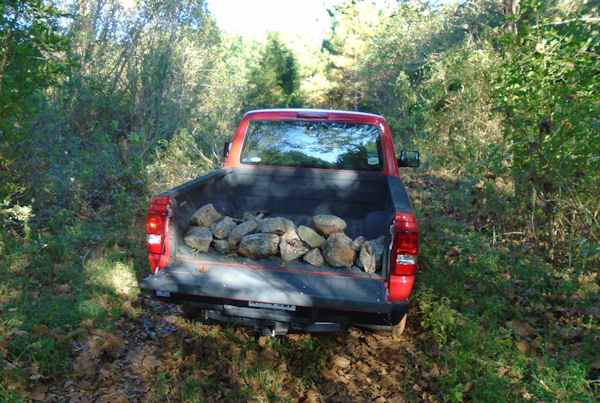
Chrissy wanted some rocks to shore up the side of her garden. The local garden shops sell rocks and they cost a lot. On the other hand, they are just kind of lying around on the farm. So I brought some back, saving hundreds of dollars.
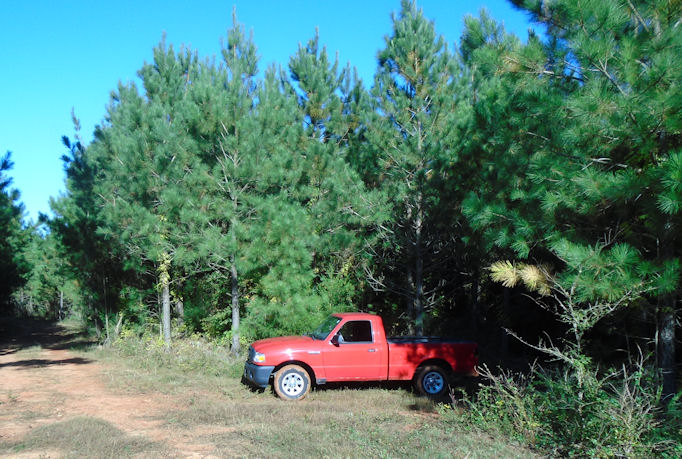
The farms are looking good. The picture that I am taking with the truck as comparison is getting harder to do as the trees grow bigger. I have to get farther back. Above is my recent picture, below is 2009. We are getting to canopy close, a phase transition. The farm seems smaller now. You can’t see long distances. On the other hand, you can now see into the forest as the lower branches are brush as dying back.

I have to say that it was an act of faith. I am not sure I ever believed the trees would really grow. The picture below is near the same place in 2007. Didn’t have a truck back then, so you can see the boys for comparison.

Besides picking up rocks, I didn’t do much work. I chopped out some brush to protect my bald cypress. This is kind of my pet tree. I figure it will be magnificent someday as long as I keep down to competition, mostly box elders. I have nothing against box elders in general. They remind me of Milwaukee. Lots of them grew near the railroad tracks where we used to play. But they are weedy and will overwhelm my cypress. I also pulled out some vines climbing my pines. We have Japanese honeysuckle. These are beautiful vines with nice smelling flowers, but they are invasive and can cover trees in short order if left alone. I know that my efforts are only a piss in the ocean, but it gives me an excuse to do something with my trees. I cut brush and pulled weeds for more than six hours. It was enough exercise to make me very sore the next day.
George C Marshall and Loudon County
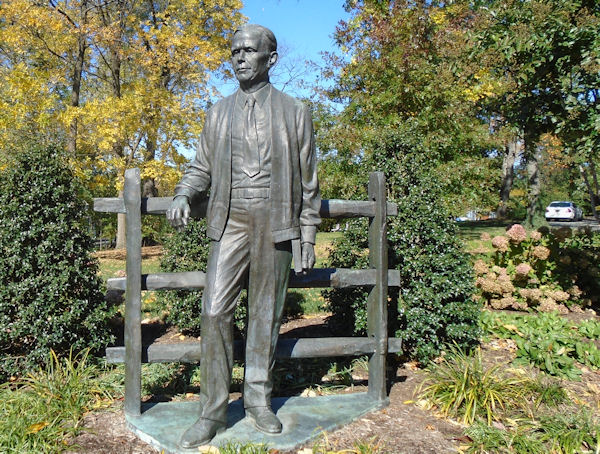
George C Marshall was a model soldier & civil servant. Winston Churchill called him the organizer of victory in World War II and FDR relied on him. He took his duty very seriously and was uniformly excellent the things he did. He was crucial both to winning the war and securing the peace after the fighting was over. The Marshall Plan is probably the greatest act by a victor in any conflict in world history. But he was a fantastically modest man. He never pushed himself forward and unlike most other great men of the time refused to keep a journal or write memoirs. Winston Churchill quipped, “History will be kind to me for I intend to write it.” Marshall refused to make is easy even for others to sing his praises.
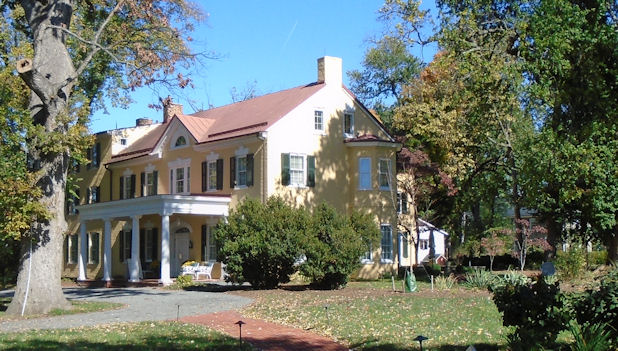
Alex and I visited his house in Leesburg today. It is a modest place considering the greatness of the man, but houses were generally smaller back then. Marshall was attracted to the garden. Gardening was his hobby and preferred method of recreation. He also rode horses.
The house is modestly furnished, but the furnishings are interesting as they reflect Marshall’s career and many of the great people he knew. He spent a lot of time in China and has furniture and art from there. Madame Chiang stayed at the house her gifts are still there. There was a painting by Winston Churchill. A copy still hangs there depicting a scene in Morocco, but the original was worth too much and was sold at auction. There are two portraits of Robert E. Lee, one as a young man and the other the more familiar one when he was older. Marshall admired Lee and tried to model his own behavior on Lee’s.
This was the first house Marshall really owned, having lived in U.S. Army quarters most of the rest of his life. He and his wife shopped estate sales for most of the other furniture.
The house is complicated because parts of it accreted onto older structures. There is an original house literally swallowed by a newer one. You can see this in one of the halls, as the internal wall has windows that used to face outward.
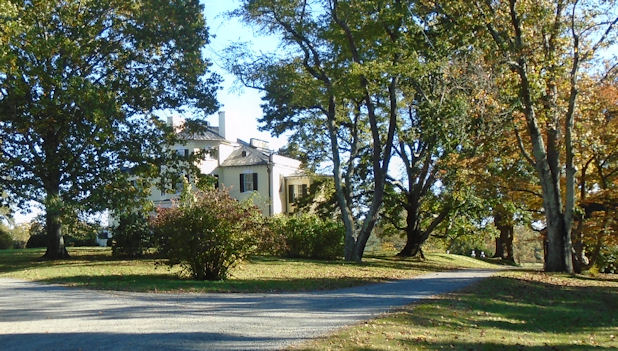
This part of Loudon County is very pleasant, rolling hills and lots of green. It is full of historical sites, mostly well-maintained. We also went to a place called the Oatlands, not far from George C Marshall’s place. It was a big estate that grew mostly grains. Later it became mostly a residence. There is a wonderful garden in that traditional Virginia style.

The house at Oatlands had lots of interesting stories. We met a delightful old lady who seemed to know all of them. She told us the about the family, related to “King” Carter, once the richest man in the colonies and about the Corcoron side of the family that endowed the famous galleries. Behind a door was maybe the most interesting thing, if small. It was a lock of George Washington’s hair. One of the extended family members, Robert Livingston, was the one who administered the presidential oath to Washington and got this as a gift. The family had quite a network.
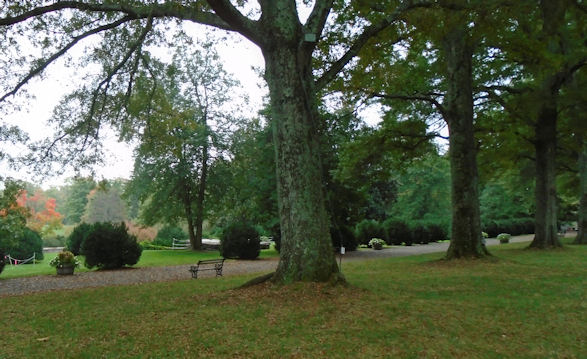
A great man I had never heard about
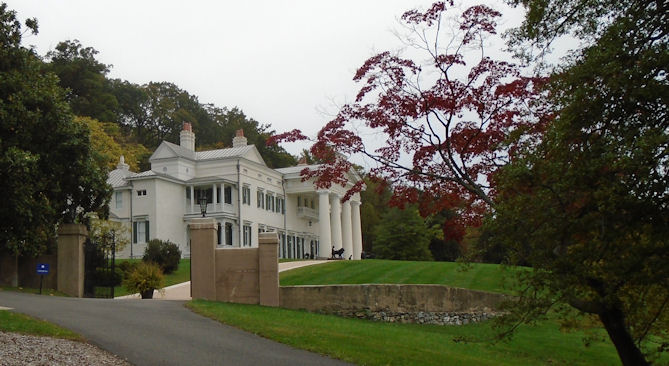
Westmoreland Davis lived a long and interesting life. He was born into a rich Virginia family that had most of its money investing in Virginia state bonds just before the Civil War. It seemed like a good safe investment. His father died and left his mother with those bonds and not much else. But Westmorland came back. He got a full-scholarship to VMI and then went to UVA and Columbia to study law, went into the law and made a fortune. After he made his fortune in the law, he decided to do something completely different and become a farmer.
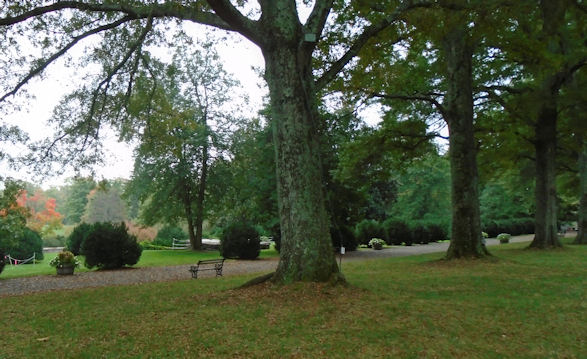
Loudon County in those days was a backward, rural area with soil depleted by poor farming practices and tobacco. Most of the farmers still practiced farmed the way their grandfathers had but with less to work with. It was not an auspicious place to start, although I suppose no experience in farming might be a bit of an advantage when those with experience are doing things wrong.
There were other pluses. Westmorland was well-financed. He wanted his farm to make money, but it really didn’t need to. But his biggest advantage was his scientific mind. He scanned the world for best practices, tried them out in Virginia, improved them and then shared them with his neighbors.
Besides providing a good local example of what could work, his main vehicle to communicate was a magazine called “The Southern Planter.” In this, he discussed what he had learned and he never wrote about anything he had not understood or tried himself. He brought in better quality animals, including Guernsey cows to improve Loudon dairy herds. Among his biggest contributions was more extensive liming of the soil. Liming to sweeten soil was understood, but imperfectly. Westmorland discovered that it took a lot more than most people thought, or could afford, so he also worked with suppliers and railroads to lower the costs.
Besides farming, Westmorland’s passion was fox hunting. He was the master of the hunt, which meant that his job was to get permission from local landowners to cross their land and offer compensation for any damage. This and his farming examples put him in touch with lots of people and he became locally famous and well-esteemed. Which helped in his next unusual career move; he ran for governor of Virginia. And he won. He came into office at an interesting time, in 1918 just as the U.S. was getting into the full swing of World War I. Of course, troops from Virginia were participating.
Virginia governors, then as now, can serve only one four-year term. After his term, Westmorland ran unsuccessfully for Senate and then returned to his farming. He became one of America’s leading producers of turkeys.
I learned about this great man who I had never heard of before when I went with Alex to visit Morven Park, his home in Loudon County. As part of Alex’s classes on preservation, he has to visit various local historical sites in order to analyze how they are presented. My pictures show the outside of the Morven Mansion. Taking pictures inside was not allowed. Pity. Westmorland traveled the world and collected all sorts of things. The house is kind of a museum. It is very pleasant and bright. He had a whole wall of Flemish tapestries that were very nice, but you can imagine some of furniture in the collections on the set of the Adam’s family.
Clean Water: Pass it Along
Our well-managed Virginia forests produce a variety of “ecological services” things like carbon sequestration, flood control, wildlife habitat, and recreation. These things rarely turn up on balance sheets, but you clearly see their value if you don’t have them.
Science beats superstition – for now

I went to the signing ceremony of a book about the Kennewick Man at the Natural History Museum. Douglas Owsley, the author, is a real hero. He stood up to the forces of politically correct superstition to get the science done.
The Kennewick Man skeleton was discovered in Washington State back in 1996. At first they thought it was the skeleton of a settler, since he did not have characteristics of Native Americans. They were surprised to find that it was more than 9000 years old.
At that point, the local Indian tribes claimed him and demanded that scientific investigation stop. They wanted to destroy the remains, i.e. rebury them and not tell where. According to their creation myths, they had always been there, so anybody from there was theirs. “From our oral histories, we know that our people have been part of this land since the beginning of time. We do not believe that our people migrated here from another continent, as the scientists do.”
I am not a believer in creation science, whether usual or native varieties. I respect that some people do believe this stuff, but I don’t believe we should give them the authority to veto science, but this was what was happening. Read the linked article. I think you will be appalled by what our government mindlessly did. They went so far as to destroy (vandalize) the site.
The lesson is that science is never really settled. We should never legislate science or stand in the way or inquiry. Pre-history is more complex than we like. The ancestors of the Native American were not the only ones and maybe not the first to enter North America. Telling this story should be the work of historians and scientists, not tribal leaders, politicians or bureaucrats.
We are still not safe. The remains are still held by the ACE and the tribes are still trying to get them bones “back” so that they can remove them forever from scientific study. But we have learned a lot already. An important lesson already is that races are not permanent. This man would belong to none of the modern ethnic groups or races. We are always in a state of change.
New Deal murals

The Smithsonian Museum of American Art did a program today on the mural art of the New Deal, especially emphasizing the work of Texas Artist Tom Lea. These murals were commissioned by the government during the Great Depression. They were meant to give artists useful work and celebrate America in all its regional diversity. Most were in public buildings such as post offices, which is why they are currently in some peril. Structures from the 1930s are often reaching the end of their useful lives. They are being torn down or converted to other uses.
What I found particularly interesting was the relationships between artists, officials and the people. This art was never meant as a personal expression of an individual artist. They were designed by committee; the community made decisions about themes and sometimes about details. This is what makes them more interesting.
They are not about the artists themselves and their particular vision. They are bigger than the artist. They are indeed about self-expression, but not merely self. Artists were paid in installments. If they produced something their patrons didn’t want, they might not be paid. Maybe because it is not the work of an individual artist, the murals are full of allegory and symbolism. They celebrate the town or region. Since they were meant to be in public places where people would see them every day, they had to make sense to people every day. The government paid the artists, but the work was truly market driven.
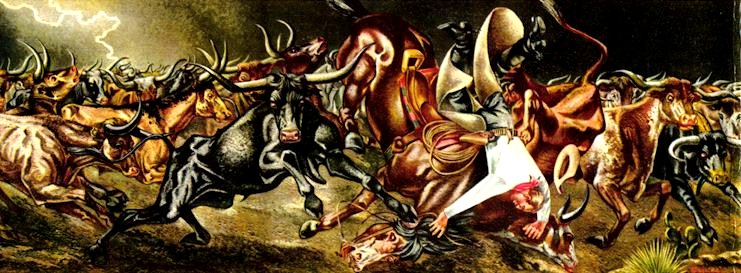
The focus was a case study of the Texas artist Tom Lea and particularly a mural he did called stampede done for the post office in Odessa, Texas. Originally, the mural was high on a wall over the tellers. When people came in, they looked up at it and probably had time to contemplate it while waiting in line. It was moved when a new post office was built nearby, but it was placed in an out-of-the-way place and at eye level. Context is important. Is it really the same work of art in its new location?
Dilettantes dilemma
If you look at the plight of adjunct faculty, it is not a good place to be. Adjunct faculty is paid not very much and they often have to cobble together several jobs to make ends meet. Enter former diplomats or former executives or former anything. We are looking for something interesting and useful to do, but we are not very much concerned with earning money or improving working conditions. For us it is just fun. We provide competition for people who want to make a career in the field and it is tough competition because we are willing to work for peanuts. So the generative, generous and selfless endeavor starts looking less benign.
